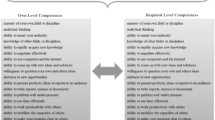Abstract
The labour market rewards for a number of required human capital competences are analysed using a sample of young European higher education graduates. Factor analysis is applied to classify competences by jobs into eight orthogonal groups, namely participative, methodological, specialised, organisational, applying rules, physical, generic and socio-emotional competences. Estimates for the total rewards for competences are obtained through conventional wage regression, whereas estimates of the total rewards are derived in terms of job satisfaction through ordered logit regression. Explanatory variables include personal characteristics, job attributes, occupational titles, fields of study, type of higher education institution and country dummies. Results on wage rewards show that jobs with higher requirements of participativeand methodological competencesare best paid; conversely, jobs with higher requirements of organisational, applying-rulesand physical competencesare worse paid. Results on total rewards suggest that jobs with higher requirements of competences increase graduates' satisfaction, the only exception being applying-rules competences.
Similar content being viewed by others
REFERENCES
Allen, J. & Van der Velden, R. (2001). Educational Mismatches versus Skill Mismatches: Effects on Wages, Job Satisfaction and On-the-job Search, Oxford EconomicPapers 53(3), 434–452.
Arrow, K. (1997). The Benefits of Education and the Formation of Preferences. In J. R. Behrman & N. Stacy (eds), The Social Benefits of Education. Ann Arbor: University of Michigan Press.
Becker, G. S. (1993). Human Capital: A Theoretical and Empirical Analysis withSpecial Relevance to Education. New York: Columbia University Press, NBER.
Becker, G. S. (1964). Human Capital- A Theoretical and Empirical Analysis, withSpecial Reference to Education. New York: National Bureau of Economic Research, Columbia University Press.
Belfield, C. R., Bullock, A. D. & Fielding, A. (1999). Graduates' Views on the Contribution of Their Higher Education to Their General Development: A Retrospective Evaluation for the United Kingdom, Research in Higher Education 40(4), 409–438.
Bishop, J. H. (1995). Vocational Education and At-Risk Youth in the United States, Vocational Training European Journal 6, 34–42.
Bishop, J. H. & Kang, D. (1989). Vocational and Academic Education in HighSchool: Complements or Substitutes?, Economics of Education Review 8(2), 133–148.
Bowen, H. R. (1977). Investment in Learning. San Francisco: Jossey-Bass Inc.
Buchel, F. (2002). The Effects of Overeducation on Productivity in Germany- The Firms' Viewpoint, Economics of Education Review 21, 263–275.
Bunk, G. P. (1994). Teaching Competence in Initial and Continuing VocationalTraining in the Federal Republic of Germany, Vocational Training European Journal 1, 8–14.
Busato, V. V., Prins, F. J., Elshout, J. J. & Hamaker, C. (2000). Intellectual Ability, Learning Style, Personality, Achievement Motivation and Academic Success of Psychology Students in Higher Education, Personality and Individual Differences 29, 1057–1068.
Card, D. (1999). The Causal Effect on Education on Earnings. In O. Ashenfelter & D. Card (eds), Handbook of Labor Economics, Vol. III. Amsterdam: Elsevier Science B. V.
Campbell, P. B. & Laughlin, S. (1991). Participation in Vocational Education: AnOverview of Patterns and Their Outcomes, Columbus. In National Centre for Research in Vocational Education.
Clark, A. E. & Oswald, A. J. (1996). Satisfaction and Comparison Income,Journal of Public Economics 61, 359–381.
Cohn, E. & Addison, J. T. (1998). The Economic Returns to Lifelong Learning in OECD Countries. Education Economics 6(3), 253–307.
Dolton, P. J. & Makepeace, G. M. (1990). Graduate Earnings After Six Years: Who are the Winners?, Studies in Higher Education 15(1), 31–55.
Green, W. H. (1997). Econometric Analysis, third edition. New Jersey: Prentice-Hall.
Hartog, J. (1992). Capabilities, Allocation and Earnings. Boston: Kluwer.
Haveman, R. H. & Wolfe, B. L. (1984). Schooling and Economic Well-Being: TheRole of Nonmarket Effects, Journal of Human Resources 19(3), 378–407.
Heijke, H., Meng, C. & Ramaekers, G. (2002). An Investigation into the Role ofHuman Capital Competences and Their Pay-Off, Research Memorandum, ROA, Maastricht.
Iyigun, M. F. & Owen, A. L. (1999). Entrepreneurs, Professionals and Growth, Journal of Economic Growth 4, 213–232.
Kellermann, P. (in press). Acquired and Required Competencies of Graduates. In U. Teichler (ed. ), Careers of University Graduates: Views and Experiences inComparative Perspectives. Dordrecht: Kluwer.
Kettunen, J. (1997). Education and Unemployment Duration, Economics of Education Review 16(2), 163–170.
Kiefer, N. (1985). Evidence on the Role of Education on Labor Turnover, Journal ofHuman Resources 20(3), 445–452.
Leckey, J. F. & McGuigan (1997). Right Tracks-Wrong Rails: The Development of Generic Skills in Higher Education, Research in Higher Education 38(3), 365–378.
McMahon, W. (1998). Conceptual Framework for the Analysis of the Social Benefitsof Lifelong Learning. Education Economics 6(3), 309–346.
Nordhaug, O. (1993). Human Capital in Organizations, Competence, Training and Learning, Oxford University Press, Bergen.
Pike, G. R. (1995). The Relationship Between Self-Reports of College Experiencesand Achievement Test Scores, Research in Higher Education 36(1), 1–22.
Psacharopoulos, G. (1994). Returns to Investment in Education: A Global Update. World Development 22(9), 1325–1343.
Rivera-Batiz, F. L. (1992). Quantitative Literacy and the Likelihood of Employment Among Young Adults in the United States, Journal of Human Resources 27(2), 318–328.
Schomburg, H. & Teichler, U. (in press). Higher Education and Graduate Employmentin Europe: Results of Graduate Survey from Twelve Countries. Kluwer Pub.
Teichler, U. & Schomburg, H. (in press). Careers of Higher Education Graduates, View and Experiences in Comparative Perspectives. Kluwer Pub.
Teichler, U. & Kehm, B. (1995). Towards a New Understanding of the RelationshipsBetween Higher Education and Employment, European Journal of Education 30(2), 115–132.
Thurow, L. C. (1975). Generating inequality. New York: Basic Books.
Weisbrod, B. A. (1964). External Benefits of Public Education: An Economic Analysis, Research Report 105, 1–143.
Witte, J. C. & Kalleberg, A. L. (1995). Matching Training and Jobs: The Fit BetweenVocational Education and Employment in the German Labor Market, European Sociological Review 11(3), 293–317.
Author information
Authors and Affiliations
Rights and permissions
About this article
Cite this article
Garcia-Aracil, A., Mora, JG. & Vila, L.E. The Rewards of Human Capital Competences for Young European Higher Education Graduates. Tertiary Education and Management 10, 287–305 (2004). https://doi.org/10.1007/s11233-004-2225-6
Issue Date:
DOI: https://doi.org/10.1007/s11233-004-2225-6




